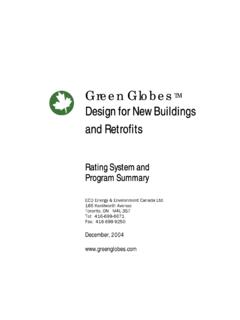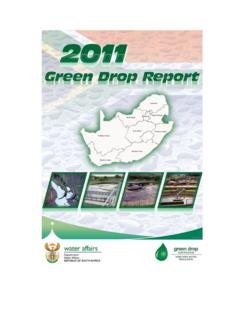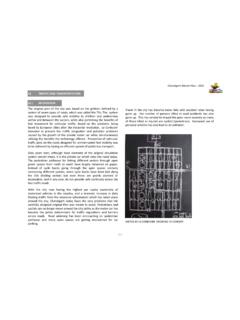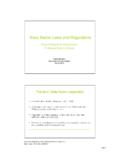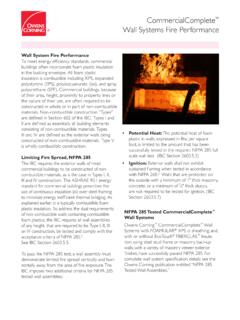Transcription of GREEN QUALITIES OF SPRAY FOAM INSULATION
1 CONTINUING EDUCATIONB uilding INSULATION is a tool for keeping heat in or out of structures. INSULATION makes it possible for buildings to stay warm in winter, cool in summer, and relatively moisture free year-round. Different types of INSULATION and air barriers have been used over the centuries with varying results. Today, new materials and technologies make it possible to create and apply extremely effective INSULATION and air barriers. The result is buildings that can maintain a safe, comfortable temperature while using very little energy for heating or cooling. This translates to greener buildings that create very low carbon footprints and meet LEED and other energy efficiency foam is a newer material that combines the benefits of INSULATION and air barriers. Because of its unique formulation and application, it consistently out-performs older, more traditional forms of INSULATION .
2 Recycled and environmentally-friendly products are available to make SPRAY foam an exceptionally GREEN choice. HOW HEAT MOVES IN BUILDINGSHeat is a form of energy which causes the molecules in gases or solids to move more rapidly. Heat tends to flow to cooler areas until all areas are at the same temperature. It moves from the warmest to the coolest parts of any structure through three mechanisms: conduction, convection, and radiation. Conduction describes the transfer of heat through materials. An example is the heat that is transferred from a stove to a pot, or from a hot liquid to a spoon. Heat and cold LEARNING OBJECTIVESUpon completion of this course the student will be able to:1. Discuss the importance of air barriers and INSULATION for reducing energy consumption and potential health and safety hazards in residential and commercial buildings.
3 2. Describe open-cell and closed-cell SPRAY foams and explain applications of Explain how SPRAY foams work as a GREEN and sustainable form of INSULATION . 4. Identify uses of SPRAY foam INSULATION to reduce fuel Discuss GREEN features of SPRAY foam INSULATION as opposed to traditional INSULATION materials and EDUCATIONAIA CREDIT: 1 LU/HSW AIA COURSE NUMBER: Use the learning objectives above to focus your study as you read this article. To earn credit and obtain a certificate of completion, visit and complete the quiz for free as you read this article. If you are new to Hanley Wood University, create a free learner account; returning users log in as QUALITIES OF SPRAY FOAM INSULATIONP resented by:By Lisa Jo RudyCONTINUING EDUCATIONcan both be conducted through materials in a building , with the result that warmth is conducted to cooler areas.
4 Some materials are better conductors than others; metal, for example, is a good conductor while wool is a poor conductor. Convection is the process by which warmer gas or liquid rises, cools, sinks, heats, and rises again. Convection can be seen in a boiling pot, or felt in a poorly insulated building . During winter, convection is the process that moves warm air from lower floors to the roof. In many cases, warm air then escapes through gaps in the building . Radiation is heat that comes from a single source and moves in a straight line. The sun produces radiant heat, as does an electric is simply a tool used to manage the flow of heat. In construction, it may be used to keep heat in or out of a building or to maintain a constant temperature. In most cases, its purpose is to slow down the process of convection and conduction, or to reflect radiant heat.
5 In a building without INSULATION , heated and cooled air move through the building and are lost to the outside environment. As a result, the heater or air conditioner must work constantly to keep the building at a comfortable temperature. Proper INSULATION , however, can keep the building at a consistent temperature for long periods of time. This means less energy spent on heating or cooling air which leads to lower environmental impacts and lower fuel maintain comfort, the heat lost in the winter must be replaced by your heating system and the heat gained in the summer must be removed by your cooling system. Properly insulating your home will decrease this heat flow by providing an effective resistance to the flow of TRADITIONAL INSULATION WORKSThe purpose of INSULATION is to stop the flow of heat from warmer to cooler areas.
6 Natural materials have been used for thousands of years to insulate homes and maintain comfort. Rock and wood can literally stop the flow of air by putting an impermeable barrier in its way. Thick, fibrous material such as wool, horse hair, or thatch can trap heat in gaps between the fibers. While these materials were somewhat effective, they left plenty of room for improvement. With new technologies, more effective materials were the 20th and early 21st centuries, foam board and fiberglass became very popular INSULATION materials. Foam boards physically block the movement of air while also slowing conduction. Spun fiberglass can be stuffed between floors and into gaps in construction, and its many layers of fibers do a good job of trapping warm air. The job of any insulating material is to stop heat from moving from one location to another.
7 The ability of any individual material to stop this flow is measured by its R-value. A high R-value means that a material is a very effective insulator, while a low R-value means the material is a poor insulator. Paper, for example, has a low R-value while thick fiberglass INSULATION has a much higher R-value of an insulating material is also based on the degree to which the material is properly installed. An inch of fiberglass material in a five-inch gap will do little to stop the flow of heat. Fiberglass that completely fills a gap will do a far better job of stopping the flow of heat, and thus produces a higher R-value. THE LIMITS OF TRADITIONAL INSULATION Standard INSULATION works in very much the same way as a sweater. Like a sweater, it is made up of layers of fibers which trap heat. In the case of clothing, however, heat is generated by the human body rather than by a furnace.
8 A sweater is perfect for cool autumn days when the sun is shining. Not only is it a thick, barrier between your warm skin and the colder air, but gaps between the fibers do a good job of trapping warm air. But what happens when rain falls or cold winds blow? Because it does not provide an impermeable barrier, the sweater provides only minimal INSULATION from stormy weather. A windbreaker is an external covering that helps stop wind and water. Put on a windbreaker over a sweater, and the sweater can do its job better. Together, the windbreaker and sweater provide an ideal climate control sweater is a good analogy for standard INSULATION . INSULATION is any material used to prevent transmission of heat or cold. Typically, structural INSULATION is made of fiberglass. In buildings, INSULATION is used to keep indoor environments separate from outdoor environments.
9 No matter what the weather outside, INSULATION acts like a sweater keeping warm air inside and helping to keep cold and heat outside. When the weather becomes very cold, hot, wet, or windy, however, gaps in fiberglass INSULATION let in the cold and drafts. That s when an air barrier becomes important. Traditional air barriers are self-adhered sheets, membranes, films, or board stock that are attached to the outside of structures to stop wind and air leakage from OF AIR LEAKAGEAir leakage is a result of pressure differences caused by the stack effect, wind loading, flues, and ventilation systems. While some air leakage is unavoidable, it can be minimized through the use of high-quality INSULATION and/or air barriers. Causes of air leakage relate to basic physics, and to the way in which structures are Stack Effect: Hot air is lighter than cold air.
10 Because of this, hot air rises to the top floors of a building . Positive pressure inside the building builds toward the roof as more air is forced into the same space. This pressure pushes air out through gaps in the ceiling and upper story are like INSULATION , while wind breakers are like air barriers. Both are necessary for proper building envelope EDUCATIONWHAT IS SPRAY POLYURETHANE FOAM? SPRAY Polyurethane Foam (SPF) is a modern polymer produced as the result of a two-component chemical reaction between a polyalcohol and a polyisocyanate. Polyurethane is an extremely popular material, as it provides a huge range of benefits. It is used in a wide range of ordinary products, including: Footwear (Shoe Soles/Cushion) Sofas Mattresses Paint Bowling balls INSULATION Roller blades wheels Golf ballsWhen it is used as an insulator/air barrier, SPRAY Polyurethane Foam (SPF) is applied as a liquid.






